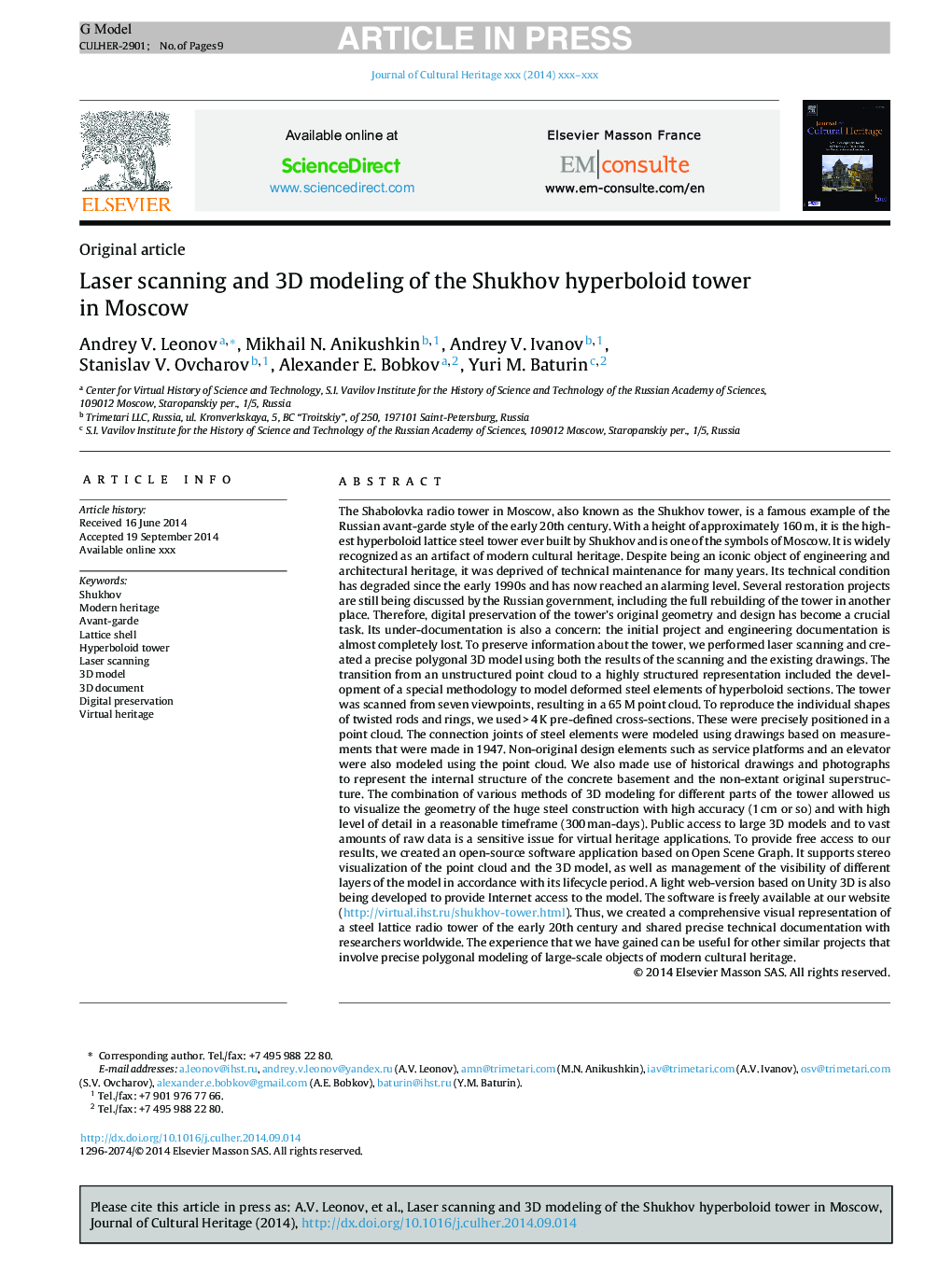| کد مقاله | کد نشریه | سال انتشار | مقاله انگلیسی | نسخه تمام متن |
|---|---|---|---|---|
| 10500007 | 944198 | 2015 | 9 صفحه PDF | دانلود رایگان |
عنوان انگلیسی مقاله ISI
Laser scanning and 3D modeling of the Shukhov hyperboloid tower in Moscow
دانلود مقاله + سفارش ترجمه
دانلود مقاله ISI انگلیسی
رایگان برای ایرانیان
کلمات کلیدی
موضوعات مرتبط
مهندسی و علوم پایه
شیمی
شیمی تئوریک و عملی
پیش نمایش صفحه اول مقاله

چکیده انگلیسی
The Shabolovka radio tower in Moscow, also known as the Shukhov tower, is a famous example of the Russian avant-garde style of the early 20th century. With a height of approximately 160 m, it is the highest hyperboloid lattice steel tower ever built by Shukhov and is one of the symbols of Moscow. It is widely recognized as an artifact of modern cultural heritage. Despite being an iconic object of engineering and architectural heritage, it was deprived of technical maintenance for many years. Its technical condition has degraded since the early 1990s and has now reached an alarming level. Several restoration projects are still being discussed by the Russian government, including the full rebuilding of the tower in another place. Therefore, digital preservation of the tower's original geometry and design has become a crucial task. Its under-documentation is also a concern: the initial project and engineering documentation is almost completely lost. To preserve information about the tower, we performed laser scanning and created a precise polygonal 3D model using both the results of the scanning and the existing drawings. The transition from an unstructured point cloud to a highly structured representation included the development of a special methodology to model deformed steel elements of hyperboloid sections. The tower was scanned from seven viewpoints, resulting in a 65 M point cloud. To reproduce the individual shapes of twisted rods and rings, we used > 4 K pre-defined cross-sections. These were precisely positioned in a point cloud. The connection joints of steel elements were modeled using drawings based on measurements that were made in 1947. Non-original design elements such as service platforms and an elevator were also modeled using the point cloud. We also made use of historical drawings and photographs to represent the internal structure of the concrete basement and the non-extant original superstructure. The combination of various methods of 3D modeling for different parts of the tower allowed us to visualize the geometry of the huge steel construction with high accuracy (1 cm or so) and with high level of detail in a reasonable timeframe (300 man-days). Public access to large 3D models and to vast amounts of raw data is a sensitive issue for virtual heritage applications. To provide free access to our results, we created an open-source software application based on Open Scene Graph. It supports stereo visualization of the point cloud and the 3D model, as well as management of the visibility of different layers of the model in accordance with its lifecycle period. A light web-version based on Unity 3D is also being developed to provide Internet access to the model. The software is freely available at our website (http://virtual.ihst.ru/shukhov-tower.html). Thus, we created a comprehensive visual representation of a steel lattice radio tower of the early 20th century and shared precise technical documentation with researchers worldwide. The experience that we have gained can be useful for other similar projects that involve precise polygonal modeling of large-scale objects of modern cultural heritage.
ناشر
Database: Elsevier - ScienceDirect (ساینس دایرکت)
Journal: Journal of Cultural Heritage - Volume 16, Issue 4, JulyâAugust 2015, Pages 551-559
Journal: Journal of Cultural Heritage - Volume 16, Issue 4, JulyâAugust 2015, Pages 551-559
نویسندگان
Andrey V. Leonov, Mikhail N. Anikushkin, Andrey V. Ivanov, Stanislav V. Ovcharov, Alexander E. Bobkov, Yuri M. Baturin,